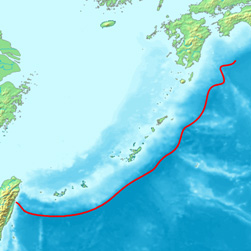 Strong trench-parallel seismic anisotropy observed in some subduction systems may be due to the presence of serpentine, writes Ian Randall.
Strong trench-parallel seismic anisotropy observed in some subduction systems may be due to the presence of serpentine, writes Ian Randall.
Geoscientist Online 5 November 2009
In the Earth, seismic anisotropy (the occasional ability of seismic waves to travel through rocks at different speeds in different directions) generally reflects the preferred orientation of crystals that have undergone deformation. In the upper mantle, this is commonly dominated by the preferred crystallographic orientation of olivine crystals.
The anisotropic material splits shear waves in two, resulting in a measurable delay between the arrival of the faster of the two waves and the slower (see "Further reading" below). In subducting systems, such anisotropy runs parallel to the trench, and the fast direction sub-parallel to it. However, large variations in the relative retardation between the two sets of shear waves are observed across different subducting systems. In north-east Japan, for example, relative delay times are 0.1-0.2 seconds, while in the Ryukyu Arc to the southwest (picture), they increase to one or two seconds.
Many hypotheses have been put forward to explain this variation, including crustal delamination, three-dimensional corner flow and slab rollback. Yet the difference (especially at the higher end of the range of relative delays) remains hard to attribute solely to the mineral properties of olivine. A team from Hiroshima University led by Ikuo Katayama has now proposed instead that the hydrous mineral serpentine might be exerting the primary control over strong trench seismic anisotropy.
Serpentine is commonly found in subduction zones where water is driven off from descending plates and their burden of oceanic ssediment. Katayama’s team performed laboratory experiments to test the mineral’s response to deformation. Antigorite, a high temperature form of serpentine, was subjected to a constant simple shear at mantle-wedge conditions, at temperatures and pressures of 300-400°C and 1GPa.
The results show not only that the c-axis of serpentine rotates with deformation to align itself normal to the plane of shear (lowering seismic wave speed in this direction) but also that serpentine anisotropy can be up to five times greater than that of olivine.
The team believes that the observed alignment, occurring in a steeply descending, hydrated slab, could explain anomalously strong trench-parallel anisotropy. The varied nature of strong trench isotropy is therefore likely to be a reflection of the non-uniform distribution of serpentine.
Reference
Nature 461, 1114-1118 (22 October 2009) Trench-parallel anisotropy produced by serpentine deformation in the hydrated mantle wedge Ikuo Katayama, Ken-ichi Hirauchi, Katsuyoshi Michibayashi & Jun-ichi Ando.
Further reading